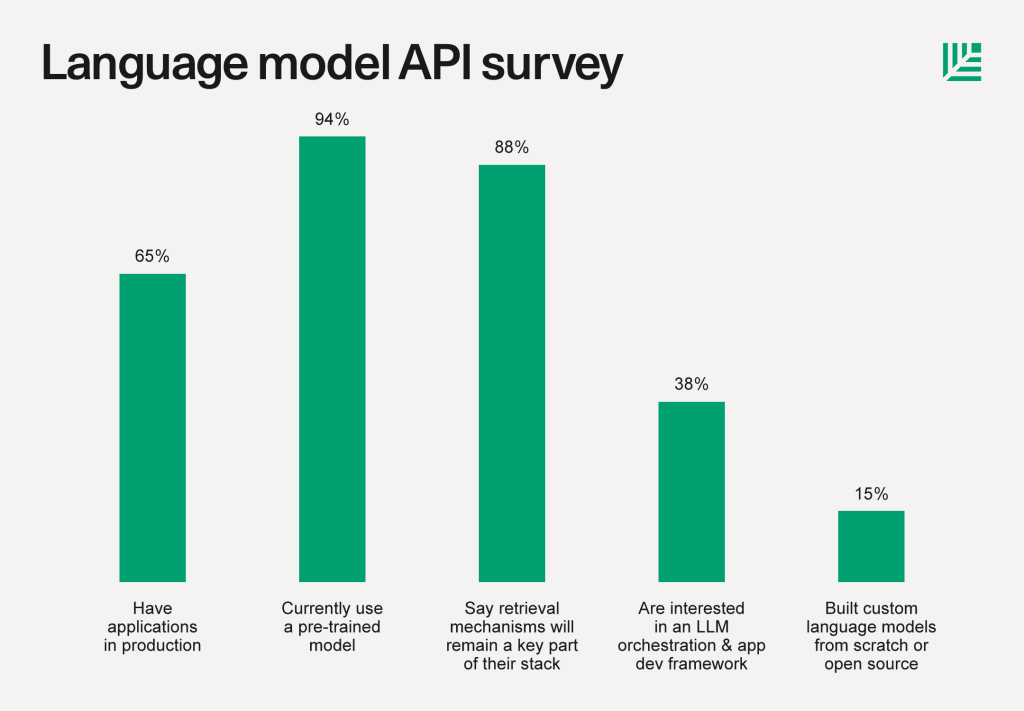|
|
Is your remote team built to last? - **Ensure your employees'** basic needs are being met first, then focus on guiding self-actualization. Don't allow anyone to feel too lost or alone. - **Large language models** center language model APIs, but open
Is your remote team built to last?
-
Ensure your employees' basic needs are being met first, then focus on guiding self-actualization. Don't allow anyone to feel too lost or alone.
-
Large language models center language model APIs, but open source is growing. They're becoming more developer-friendly, too.
-
10K organic users in 50 days. No marketing. Loop, a matchmaking app that relies on humans, not an algorithm, makes people want to share it.
Convex is the backend application platform with everything you need to build your full-stack project. Cloud functions, a database, file storage, scheduling, search, and real-time updates fit together seamlessly, and are accessible from client libraries for your favorite environment. Start building your full-stack app with Convex today. #ad
Want to grow your business? Try running a promo in the Indie Hackers newsletter to get in front of nearly 80,000 founders.
Building a Long-Lasting, Effective Remote Team 🌎

by Igor Debatur
I've grown Uploadcare to several million in ARR, with a team of 35 remote workers. Here's how to optimize remote work for your company!
Meet people's needs
Maslow's hierarchy of needs gives a good overview of how to help motivate people:

The basic needs at the bottom are the easiest to solve, but can sometimes be overlooked. If there’s a heat wave, does your teammate have AC in their apartment? If they have a baby, are they able to get rest?
As founders, we should have a good understanding of these needs. They affect remote workers more, since they're not escaping to the office every day.
Here are some ways to cover basic needs. This is not an exhaustive list:
-
Comfortable work and life environment: Rent a co-working space at the company's expense, provide them with a laptop and office setup, be mindful of cost of living in their area and ensure that their earnings address that.
-
Psychological needs: Make the ground rules easy to understand, ensure the company and product vision make sense, and make sure the tools are easy to use. (We solved this by carefully curating a thorough handbook.)
-
Professional needs: Conduct 1:1s, hold virtual meetups where team members can just chat about random topics, and encourage playing games! A study confirmed that playing together improves empathy. Also, meet in real life periodically!
Self-actualization
When you solve the bottom part of the triangle, your teammates will have all the prerequisites to work on self-fulfillment needs. If your company’s vision and strategy are aligned with a person's life goals, they will likely be more productive.
An easy way to ensure that your vision and strategy are aligned is to run a three hour brand sprint. In just a few hours, you’ll brainstorm: A roadmap, "what, how, and why" circles, how you plan to win your audience, and your company values. Check out this ready-made cheatsheet from Google Ventures.
Takeaways
- Lean into async communication.
- Help people navigate the workplace, and create opportunities for them to meet virtually and in-person.
- Only results are meaningful. Don't concern yourself with people's schedules if they're delivering.
- Don’t let people get lost or feel too alone. Help them to navigate, and make them feel they are part of a real team.
Discuss this story.
In the News 📰

The New Language Model Stack 💻

by Lauren Reeder
ChatGPT unleashed a tidal wave of innovation with large language models (LLMs). We spoke with 33 companies across the Sequoia network, and nearly every one is building language models into their products.
The new stack centers language model APIs, but open source is also growing
- 65% had applications in production, up from 50% two months ago, while the remainder are still experimenting.
- 94% are using a foundation model API. OpenAI's GPT was the clear favorite in our sample, at 91%.
- 88% believe a retrieval mechanism, such as a vector database, would remain a key part of their stack.

Everyone we spoke with said AI is moving too quickly to have high confidence in the end-state stack, but there was consensus that LLM APIs will remain a key pillar.

Companies want to customize language models
Generalized language models are powerful, but not sufficient for many use cases. Companies want to enable natural language interactions on their own data, or their users' data.
You can:
- Train a custom model from scratch: Highest degree of difficulty.
- Fine-tune a base model: Medium difficulty.
- Use a pre-trained model to retrieve relevant context: Lowest difficulty.
The stack for LLM APIs and the custom model training stack are blending together over time
Some have wondered whether LLMs being readily available via API meant companies would do less of their own custom training. So far, we're seeing the opposite.
As interest in AI grows and open source development accelerates, many companies become increasingly interested in training and fine-tuning their own models.
The stack is becoming increasingly developer-friendly
Language model APIs put powerful, ready-made models into the hands of the average developer, not just machine learning teams.
Now that language models have meaningfully expanded to all developers, we believe we'll see more developer-oriented tooling.
Language models need to become more trustworthy for full adoption
Before fully unleashing LLMs in their applications, many companies want better tools for handling data privacy, segregation, security, copyright, and monitoring model outputs.
Companies in regulated industries (fintech, healthcare, etc.) are especially focused on this.
Language model apps will become increasingly multi-modal
Companies are already finding interesting ways to combine multiple generative models to great effect: Chatbots that combine text and speech generation unlock a new level of conversational experience.
It's still early
AI is just beginning to seep into every crevice of technology. Only 65% of those surveyed were in production today, and many of these are relatively simple apps.
As more companies launch LLM apps, new hurdles will arise, creating more opportunities for founders! Check out the full article here.
Discuss this story.
Top Posts on Indie Hackers This Week 🌐

10K Organic Users in 50 Days 💝

by Omer Ben-Ami
Loop is a matchmaking app that gained 10K users in 50 days without any marketing budget. Today, we're chatting with Moriya Blumenfeld, Loop's cofounder and CEO, about the company's launch.
The key
The secret sauce to Loop's speedy growth was creating a product that users want to share. The app throws it back to matchmaking, not by an algorithm, but by human beings. When you sign up for the app, you nominate friends and family members to do the matchmaking for you. Therefore, your matchmaker is somebody who already knows you! It relies on the power of community, and allows users' loved ones to help them find love.
The app has also attracted a following among the Jewish community in the US. Although anyone can sign up, its function centers the Jewish concept of "shidduch."

The team spent a ton of time interviewing users to understand the point of high intent, and position the invite call-to-actions accordingly. The concept, plus the ease of sharing the app, has made users want to share it with people they know:

The focus
Moriya says that Loop's north start KPI is "K-factor."
The K-Factor is a metric inspired by the medical field. In marketing, K-factor is used to describe the virality rate of apps through referral programs or “hidden” virality, which is word-of-mouth.
In other words, K-factor measures how many new users an existing user introduces to an app or website. The formula for calculating K-factor is roughly as follows:
K-factor = (Number of invites sent by each existing user) x (Percentage of successful conversions).
By measuring the K-factor, B2C apps can determine how viral their product is, and how many new users they can expect to acquire through word-of-mouth referrals.
This is the key focus for Loop in the coming year!
For more, check out the full interview here.
Discuss this story.
The Tweetmaster's Pick 🐦

by Tweetmaster Flex
I post the tweets indie hackers share the most. Here's today's pick:

Enjoy This Newsletter? 🏁
Forward it to a friend, and let them know they can subscribe here.
Also, you can submit a section for us to include in a future newsletter.
Special thanks to Jay Avery for editing this issue, to Gabriella Federico for the illustrations, and to Igor Debatur, Darko, Lauren Reeder, and Omer Ben-Ami for contributing posts. —Channing
|
|
Indie Hackers | Stripe | 120 Westlake Avenue N, Seattle, Washington 98109
|
|
You're subscribed to the Indie Hackers Newsletter. Click here to unsubscribe.
|
|
|










